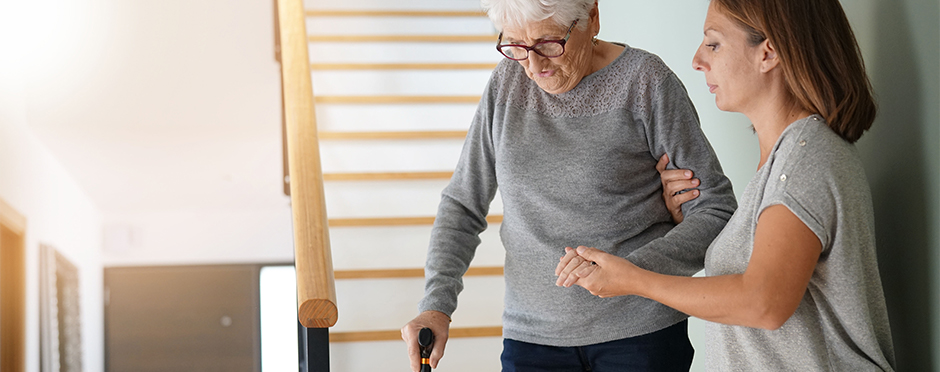
Fall Prevention: Tips to Prevent Falls
1 CommentMary Lehnen, PT, DPT and Laura Flanigan, MSOT, OTR/L
Why is fall prevention important? Physical and occupational therapists frequently treat patients whose injuries were caused by a fall. According to the Centers for Disease Control and Prevention (CDC), falls are the leading cause of fatal and nonfatal injuries for adults who are 65 years and older. Falls can lead to serious nonfatal injuries, including fractures of the head and hip. A fall on an outstretched hand, also known as a “FOOSH” injury, can lead to fractures and soft tissue tears of the hand, wrist, forearm and even the shoulder. Falls can be emotionally traumatic to some patients and they may avoid participating in exercise, leisure and necessary daily activities due to fear of falling. This can lead to deconditioning, isolation and negatively impacting an individual’s overall well-being and independence.
What Increases Your Risk of Falling?
Many factors, including those related to an individual and their environment, can impact a person’s fall risk. One of the first factors that comes to mind for many is balance, which is controlled by three body systems – vision, vestibular, and sensation, specifically light touch sensation. This means that the brain relies on visual fixation on objects, the sense of where our bodies are in space, and the sensation of stable ground beneath our feet. Disruptions to any of these three systems may impair balance. These may include cataracts and retinopathy, diabetic neuropathy, vertigo, foot drop, or mechanical problems of the legs or feet. You can improve your balance by appropriately stimulating each aspect based on your condition. For example, in patients with diabetic neuropathy who have reduced sensation in the feet and therefore have a reduced ability to feel the ground beneath the feet, you can stimulate your visual and vestibular systems by closing your eyes and practicing weight shifts, respectively. This will help to improve the visual and vestibular systems’ input to the brain and accommodate given the condition. Below is a breakdown of the three body systems that make up your balance and methods to improve each system.
- Visual
- Closing your eyes, dimming the lights, use of moving images
- Vestibular
- Weight shifting, moving the arms/legs, walking
- Sensation
- Unstable surfaces (balance board, foam pad, BOSU, pillow), walking with supportive shoes
Methods to Prevent Risk of Falling2
Whether you or someone you know is impacted by any of the above conditions, there are ways that you can easily modify your environment, daily activities and your routines to prevent falls.
- Remove clutter in your home and walk carefully around pets and throw rugs.
- Never stand on chairs or unstable objects to reach for something overhead. Ask for help or use a sturdy ladder when appropriate. Rearrange your storage spaces, such as kitchen cabinets and linens closets, so that necessary items that are frequently used are within your reach.
- Do not hold onto towel bars or soap dishes in the shower/bathroom because they may come away from the wall. Instead, an occupational therapist can evaluate your living space to determine where grab bars can be safely installed for support.
- Make sure you have good lighting that does not create a glare, especially in stairwells and where there are steps. A nightlight or motion sensor light can be helpful in the bedroom and bathroom.
- Be aware of your limits – if you do not think you can safely do something, ask for help.
Physical or occupational therapy can be your first stop for fall prevention and improvements to your balance. Click the button below to schedule a free assessment at a nearby Athletico today!
The Athletico blog is an educational resource written by Athletico employees. Athletico bloggers are licensed professionals who abide by the code of ethics outlined by their respective professional associations. The content published in blog posts represents the opinion of the individual author based on their expertise and experience. The content provided in this blog is for informational purposes only, does not constitute medical advice and should not be relied on for making personal health decisions.
References:
1. Centers for Disease Control (CDC) and Prevention, 2015. Preventing falls: A guide to implementing effective community-based fall prevention programs. <https://www.cdc.gov/homeandrecreationalsafety/pdf/falls/fallpreventionguide-2015-a.pdf>
2. American Occupational Therapy Association (AOTA), 2012. Fall prevention for people with disabilities and older adults. <https://www.aota.org/About-Occupational-Therapy/Patients-Clients/Adults/Falls/FallPreventionwithDisabilitiesandOlderAdults.aspx>

1 Comment
Jesse Auerbach
Excellent PT for my two outdoor falls from Athletico on Morgan. Thank You all!
My doctor advised NOT wearing my bi-focal sunglasses as the bottom lens tends to impair sidewalk study. Helped a lot so I thought I would pass on.